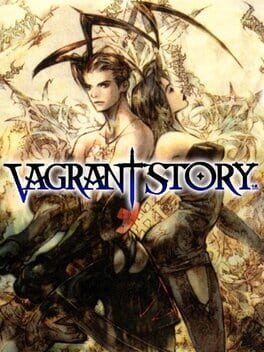Squaresoft and Yasumi Matsuno's second collaboration spawned the painstakingly crafted Vagrant Story, a hyper-intricate and hyper-mystifying gem, perhaps the culmination of the former's acrobatic presentation and the latter's disquieting writing. Alongside the visuals, what immediately stands out are the main cutscenes: A minimal and reckless form of storytelling, packed with refined - almost cryptic language and portrait-worthy shots in which characters enter, ponder and exit with (seemingly) little to no regard for identity nor coherence, only to slowly decode a tragic plot and cast as it proceeds. The best moments - in particular, emit an immersive yet disorienting atmosphere that reminds one of the more abstract, ghostly experiences of Xenogears' second disc, while others are boss fight intros rendered in creative and dramatic ways. Its structure, both narratively and functionally, had little in common with JRPGs; largely indifferent to the hero's journey and to the village-to-dungeon format (basically a gradually-unraveling dungeon-crawler that disposed of the hub, shops, friendly NPCs, currency, etc.), which becomes an attraction in itself.
Equally original is the gameplay, ostensibly a mix of action-adventure, platforming and ARPG whose combat combines free movement with menu-selection pauses (reminiscent of Parasite Eve minus the ATB gauge) and damage-able limbs a la Front Mission. But in reality, it's the systems that tower over the rest; dense and overwhelming in a vein similar to Ogre Battle (another Matsuno-led project). The most striking aspect is probably how one's equipment factors into hit/damage calculations, utilizing not one but three sets of resistances + weaknesses (affinity, class and type, i.e. elements, species and weapon blades, respectively), and partly governed by mutating stat levels (e.g. Fire, Undead, Piercing) tied to both gear and enemies. At the same time, mechanics such as Break Arts (weapon-exclusive supers unlocked via use-based mastery), Chain Abilities (that evolves SMRPG via quasi-unlimited, unlockable offensive/defensive follow-ups), and especially the aptly-named RISK (a secondary meter that trades accuracy and defense for crit-rate and healing power as chains accumulate) add even more rules and layers to this peculiar brand of strategic-action. This game's most trivial system would be a main feature on other RPGs.
Other - but no less vital mechanics complement the more distinguished ones, ranging from crafting, weapon mods, equipment tiers, durability, proficiency, etc. Altogether, these ideas form a convoluted web of interactions that turns each encounter into a flexible customization challenge, where bosses can either last for 20 minutes or fall to a single chain combo. Not even its many drawbacks (the overdemanding and sometimes hopeless early-game situations, the constant menu setup and the input-bloat) could spoil this multifaceted type-matching approach. By the end, the player has gathered and honed a virtual toolbox of equipment, magic and augments to construct specialized builds for any battle scenario.
A veritable alien JRPG encyclopedia, elegant and puzzling, theatrical but never awkward nor melodramatic, complicated yet intriguing, Vagrant Story absorbs and weaves together concepts from all sorts of past games without belonging to any of them.
Equally original is the gameplay, ostensibly a mix of action-adventure, platforming and ARPG whose combat combines free movement with menu-selection pauses (reminiscent of Parasite Eve minus the ATB gauge) and damage-able limbs a la Front Mission. But in reality, it's the systems that tower over the rest; dense and overwhelming in a vein similar to Ogre Battle (another Matsuno-led project). The most striking aspect is probably how one's equipment factors into hit/damage calculations, utilizing not one but three sets of resistances + weaknesses (affinity, class and type, i.e. elements, species and weapon blades, respectively), and partly governed by mutating stat levels (e.g. Fire, Undead, Piercing) tied to both gear and enemies. At the same time, mechanics such as Break Arts (weapon-exclusive supers unlocked via use-based mastery), Chain Abilities (that evolves SMRPG via quasi-unlimited, unlockable offensive/defensive follow-ups), and especially the aptly-named RISK (a secondary meter that trades accuracy and defense for crit-rate and healing power as chains accumulate) add even more rules and layers to this peculiar brand of strategic-action. This game's most trivial system would be a main feature on other RPGs.
Other - but no less vital mechanics complement the more distinguished ones, ranging from crafting, weapon mods, equipment tiers, durability, proficiency, etc. Altogether, these ideas form a convoluted web of interactions that turns each encounter into a flexible customization challenge, where bosses can either last for 20 minutes or fall to a single chain combo. Not even its many drawbacks (the overdemanding and sometimes hopeless early-game situations, the constant menu setup and the input-bloat) could spoil this multifaceted type-matching approach. By the end, the player has gathered and honed a virtual toolbox of equipment, magic and augments to construct specialized builds for any battle scenario.
A veritable alien JRPG encyclopedia, elegant and puzzling, theatrical but never awkward nor melodramatic, complicated yet intriguing, Vagrant Story absorbs and weaves together concepts from all sorts of past games without belonging to any of them.
